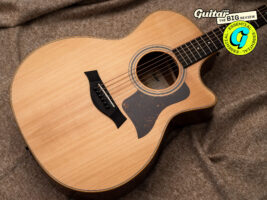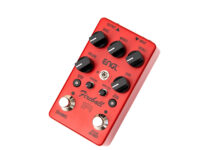
Taylor 314ce Studio review: “Forget where the neck is made, this is every bit the US-made instrument”
$1,999 / £1,799 (Tobacco stain finish with Shaded Edgeburst top is $2,099/£1,899), taylorguitars.com
Taylor has been at the forefront of guitar innovation for 50 years now, finding clever and boundary-pushing solutions to offer improved tone, playability, and now it seems… value? Not that the US company has never made affordable acoustics before of course – the brand has had huge success with its Tecate-made 100, 200 and Academy Series guitars, and especially the wildly popular and excellent GS Mini range.
READ MORE: Guild DS-240E review – “This acoustic proved me wrong about soundhole pickups”
A US-made Taylor – and indeed any US-made acoustic guitar – remains a lofty proposition for many of us, however. The Taylor 314ce guitar currently costs $2,499, but now we have a new entrant into the range that has lowered the price of entry to Taylor’s flagship to just under $2,000 – the 314ce Studio.
Image: Adam Gasson
Taylor 314ce Studio – what is it?
Billed as the “lowest-priced gateway to the solid-wood experience in the Taylor line”, on the surface there doesn’t seem to be too many compromises from the full-fat version. The Studio’s top is spruce (though torrefied as opposed to the 314ce’s Sitka), the back and sides are sapele just like its bigger brother, and the neck is mahogany and the fingerboard ebony.
Both guitars are gloss-finished, though the Studio has a chamfered body edge with simple pinstriping instead of traditional black body binding. While both instruments utilise Taylor’s revolutionary V-class bracing architecture, there are some other subtle differences – the peghead has no inlay here, and the nut is NuBone as opposed to Tusq, while the bridge pins are plastic, not ebony. Both guitars have identical Taylor tuners, and use the same ES-2 pickup system… so… where’s that $500 saving being found?
In short, you’re getting a cheaper guitar because not all of it is being made in the USA. Specifically, the 314ce Studio’s necks are being made in Mexico at Taylor’s Tecate facility. These necks are then shipped over the border to the main factory in El Cajon, where they’re assembled in the same way (and by the same luthiers) as any other Taylor guitar.
It’s a simple but innovative way to save money. After all, the Taylor neck is a marvel of the CNC-milled precision that is used at most of the brand’s price points – so you could well argue that it makes very little difference if said CNC is doing its tireless robot work in a factory in the USA or 30 miles away just over the Mexican border.
The issue will be whether that saving lasts. In a world where tariff-free trade is the norm, such an innovative approach to cost saving would be a no-brainer… but who honestly thinks that world still exists?
If NAMM isn’t successful in lobbying the US government for exemptions on tariffs for musical instruments and components, these compelling price points could rapidly become untenable. But that is very much a discussion above the pay grade of this review, so let’s find out how this guitar performs.
Image: Adam Gasson
Taylor 314ce Studio – playability and feel
Most of us understand that there tends to be a law of diminishing returns when it comes to guitars – when you start to get into the premium end of the market, you can end up paying a lot more for a guitar that’s only a small amount better.
The 314ce Studio sits at the sweet spot of that bell curve – it feels like a superior and more high-end instrument than Taylor’s entirely Mexico-made guitars, while still offering a price point that’s not completely beyond the realms for acoustic players looking to step up.
The action is set up perfectly straight out of the box,, and when paired with Taylor’s “easy-playing” neck profile, satin-finished neo-tropical mahogany neck and West African Crelicam Ebony fretboard, it means a playing experience conducive to thoroughly enjoyable, long sessions. Throw into the mix that beautifully balanced, earthy tone, and you’ve got an instrument you won’t be in a rush to put down.
With some acoustic guitars, the difference in fretboard action between the lower and upper frets can be quite pronounced. Thankfully, with the 314ce Studio, this is no such problem, as its action is essentially uniform the length of the fretboard, meaning you can make full use of that Venetian cutaway while dabbling in the guitar’s upper registers.
It’s also worth noting the 314ce Studio’s rock-solid tuning stability; a superbly built acoustic guitar is only as good as its tuning reliability, and in this regard, the 314ce Studio scores full marks. The 21:1 ratio of the Taylor nickel tuners means on-the-fly micro-adjustments are easy, too.
Image: Adam Gasson
Taylor 314ce Studio – sounds
As is generally a fair way to compare the sound of acoustic guitars with one another, I was quick to enforce the G major chord test on the 314ce Studio. Though that was just after some micro tuning adjustments were made – totally fair considering it just came out of its transit box – that first G major chord was nothing short of magical.
The guitar’s tonal profile is divinely balanced, with a warm, woody low-end subtly punctuated by a crystalline sparkle, while boasting a punchy midrange bolstered in large part by the guitar’s torrefied spruce top.
The V-Class bracing is a recipe for a remarkably in-tune and intonated instrument, and it delivers this in spades all the way up the fretboard, but one of the lesser talked about benefits of the bracing pattern is that it also dials up the sustain. This really struck me in practice, as the transient tails of chords strummed with the 314ce are luxuriously long when allowed to ring out.
Taylor’s Expression System 2 has been around for a while now, and it does things a little differently to a lot of other piezo-based pickup systems. In a world of LR Baggs AEG-1 and other cutting edge acoustic pickups, it still has a little of that piezo honk about it comparatively, but it still does a pretty damn good job all these years later.
It helps that the custom-designed preamp in the ES-2 system helps mitigate a lot of these compressed characteristics somewhat, faithfully reproducing a wide range of dynamics, so what you hear when running through a PA system is close enough to your unplugged tone to be perfectly usable.
Image: Adam Gasson
Taylor 314ce Studio – should I buy one?
$2,000 is still a lot of money to spend on an acoustic guitar, and you can of course get plenty of bang for your buck for a lot less money – that’s a valid consideration, but it’s important to take this guitar in context.
This is a guitar that has been almost completely built in the same Taylor factory as the brand’s other US-made instruments. And as for the bit that isn’t… well if you hadn’t told me that the neck was made in Mexico, I’d have had no idea, and likely neither would you.
All this means that it offers a seriously impressive amount of quality, build and feel for the price point – if you’re looking for a ‘proper’ Taylor guitar, don’t be put off by any of the chatter, this feels every bit a US Taylor instrument. And it could be your new lifelong companion.
Image: Adam Gasson
Taylor 314ce Studio – alternatives
Another US brand taking advantage of hybrid build to make a more affordable instrument is Bourgeois – albeit with a bigger carbon footprint! The Touchstone series ($3,299/£2,899) has their tops made in the USA, then shipped to Eastman’s factory in China where they’re attached to bodies and necks. Yamaha’s Red Label guitars are rightly iconic as amazing studio guitars, and the modern Red Label FGX5 ($1,750/£1,853) is a quality Japanese-made instrument. If you want pure quality plugged-in tone, you’d be hard-pressed to find a better sounding guitar than the LR Baggs AEG-1 ($1,599/£2,099).
The post Taylor 314ce Studio review: “Forget where the neck is made, this is every bit the US-made instrument” appeared first on Guitar.com | All Things Guitar.
Source: www.guitar-bass.net












